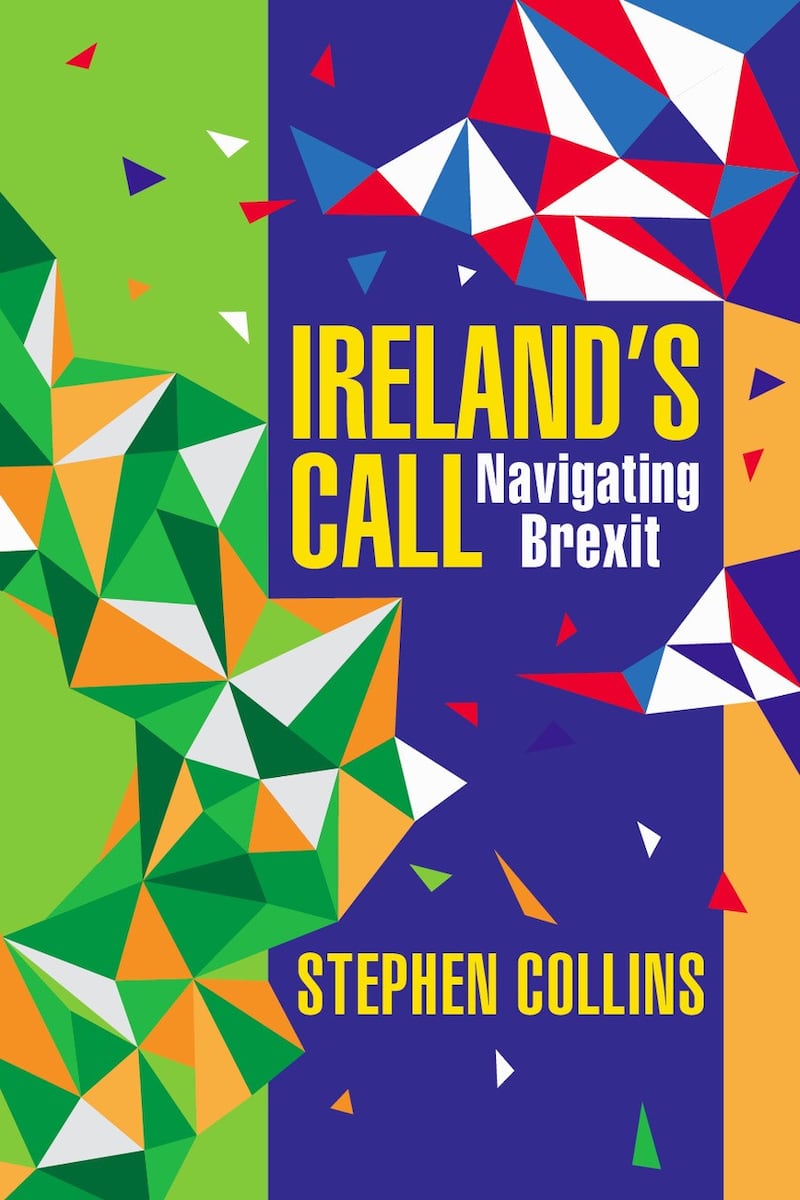When Boris Johnson became British prime minister on July 24th, 2019, it seemed the UK was on course for a no-deal Brexit given his commitment to “bin the backstop” which had been designed to prevent a hard border on the island of Ireland. It was only averted by the deal struck at the Wirral on October 10th by Johnson and then taoiseach Leo Varadkar, which replaced the backstop with the Northern Ireland protocol. The conversation between the two leaders, and the secret behind-the-scenes contacts that paved the way for the meeting, are revealed in a new book about the Brexit talks, Ireland’s Call, by Stephen Collins, which will be published next week. Below is an extract.
On September 9th, 2019, Johnson flew to Dublin for his first face-to-face meeting with Varadkar. The two men held a joint press conference before getting down to business in Government Buildings. At the press conference Varadkar’s message about the consequences of a no-deal was blunt: “It will cause severe disruption for British and Irish people alike. We will have to get back to the negotiating table quickly. When we do, the first and only items on the agenda will be citizens’ rights, the financial settlement and the Irish Border.” The then taoiseach then outlined a more optimistic scenario. “If there is a deal, and that is also possible, we will enter talks on a future relationship agreement between the EU and UK.”
Johnson was decidedly more upbeat. “I have one message that I want to land with you today, Leo, that is I want to find a deal, I want to get a deal. Like you I’ve looked carefully at no-deal, I’ve assessed its consequences both for our country and yours. And yes, of course, we could do it, the UK could certainly get through it but be in no doubt that outcome would be a failure of statecraft for which we would all be responsible.” To reinforce the point, he added: “So for the sake of business, for farmers, and millions of ordinary people who are counting on us to use our imagination and creativity to get this done, I want you to know I would overwhelmingly prefer to find an agreement.”
As political turmoil raged in the UK during that September, Varadkar’s team of officials began a cautious exploration with their British counterparts to establish if a compromise could be reached on the contentious backstop. Since early 2017 the Irish side had been very careful not to be seen to engage in bilateral discussions with the British that might be regarded as an attempt to stray outside the position as articulated by Micheal Barnier [the EU’s Brexit negotiator] and the EU Task Force. Now, however, they began a tentative diplomatic dance to see how far the British might go. “We lifted the skirt a little bit on the idea of some sort of a consent mechanism. That was the key piece at the time that was new, that hadn’t been on the table with Theresa May,” said one Irish official.
READ MORE

As part of this process a back channel was set up between 10 Downing Street and Varadkar’s office in Dublin. On the British side the key figure was Edward Lister (now Lord Udny-Lister), the chief strategic adviser to the prime minister who had been Johnson’s deputy mayor and chief of staff during most of his period as mayor of London. Aged 70, he was described in one media profile at the time as “an unassuming figure, besuited, grey-haired, respectable, like the head of a medium-size business”. He took charge of the contacts with the Irish government and quickly established a rapport with Varadkar’s chief of staff Brian Murphy.
Lister was accompanied on a number of visits to Dublin by two British cabinet office officials Brendan Threlfall and John Bew. Threlfall had headed the section in the UK Brexit department dealing with Northern Ireland and had moved to the Northern Ireland Office for a time to continue the work. At this stage he was back in the cabinet office leading the work on drafting alternatives to the backstop. The historian John Bew was a more recent addition to the process having been appointed to the cabinet office by Johnson after his accession to Downing Street.
Threlfall and Bew did the detailed drafting on the British side and worked closely with top Irish officials Martin Fraser, secretary general of the Taoiseach’s Department and, John Callinan, the lead Irish negotiator throughout the Brexit process, to establish if an alternative to the backstop could be found. The British were encouraged by their assessment that the Irish were prepared to take the risk of annoying the EU in pursuit of a deal, although Varadkar and his officials insist that they kept Barnier and his team in the loop.
The officials got down to serious work immediately after the Dublin meeting of the two leaders in early September. Following a series of phone calls and an exchange of documents a team from Downing Street came to Dublin on September 16th to meet the senior figures in the taoiseach’s office. The British team was led by Lister, whose role was to build a relationship of trust and see if the other officials on the British team could work with their Irish counterparts to agree a new strategy.
“So you had this situation where Boris had made it clear that something has to give if we’re to get this done,” recalled John Callinan. “He was playing very hard ball saying he wasn’t afraid to go with no-deal. I don’t believe he would have gone with no-deal but who knows. Nobody could say that for sure. Leo was thinking, well, we’re going to have to find some way to engage here. Just saying no is a dangerous game.”

Lister recalled that the UK side was also struggling to find a way through. “It was a very difficult time. It was very bitter in British politics at that stage with two sets of extremists in parliament, one set who just wanted out of the EU and didn’t care whether or not there was a deal and the other group who wanted us to remain in the EU and ignore the vote of the people to leave. We had to find a middle path.”
Lister accepted that the Irish side was entitled to do everything possible to avoid a hard border. “We thought the Irish had reasonable concerns and we knew that a compromise formula had to be found to reassure the government in Dublin that it would not happen. We also knew that a no-deal would be hugely damaging for Ireland so it was in the interests of both countries to find agreement. The same was not true of Brussels; they didn’t seem to care whether or not there was a deal.”
Following a number of meetings between the two sets of officials in Dublin, the way was cleared for the surprise announcement that Varadkar and Johnson would meet on October 10th. The venue for the meeting was the Wirral, not far from Liverpool, at a country house hotel called Thornton Manor, a popular wedding location.
Officials on both sides assumed the two leaders would have a short private meeting before being joined by their teams for the substantive talks. Instead the taoiseach and prime minister went for a walk in the grounds for about 20 minutes and then closeted themselves away in a room for an hour and a half where they really got down to business.
“We did a walk around the garden largely exchanging small talk as a kind of icebreaker-type thing,” recalled Varadkar. “And then we were in the room on our own for a good while. That was the longest time we were together, just the two of us over tea and biscuits. And that’s when I had a chance to put to him the concept that if the UK backstop is a non-runner then the alternative option is a Northern Ireland-only solution. I think I called it a frontstop because, unlike the backstop which would only apply at a later point if there was no trade agreement, this would apply immediately.”
Varadkar remembered Johnson’s jokey reference in their first phone call that he had to perform a “backstopectomy” and he emphasised that the “frontstop” alternative would achieve that objective. The focus of both was whether they could agree on the basic principle of how the Northern Ireland-only solution would work and what form of consent mechanism would be used to underpin it.
The officials on both sides were taken aback by how long the two men spent closeted together, and on the Irish side there was some trepidation about what might emerge
“Both of us were of the view that the technical details, around customs checks and so on, were not to be worked out by us, because neither of us would have had an expert understanding of how those things work. So the real issue that we discussed was how there would be democratic consent because that was their [the British] issue. I think that the idea of sort of a referendum in the North had been floated at some point but we very much didn’t pursue that because we just thought it would be too dangerous.”
Varadkar, though, did accept the idea that some form of consent within Northern Ireland was necessary. “I was in favour of a democratic consent mechanism. There had been talk of a time limit, which I was never willing to accept unless it was a very long time, like, maybe 50 years, but 10 years was definitely not on. So we needed some other mechanism by which the protocol backstop/frontstop could end. I said we can accept the need for a consent mechanism but it would have to be a cross-community vote to disapply it. The arrangement would apply until it was disapplied. And the discussion then went on to how the consent mechanism would be approved. Would you need a majority of both communities or would it just be a straight vote in the Assembly.
“Obviously his preference was the opposite of mine. He favoured an Assembly vote to apply it, with the decision being based on a cross-community vote. To me that represented a lack of permanency and it would be too easy to disapply it.”
The officials on both sides were taken aback by how long the two men spent closeted together and on the Irish side there was some trepidation about what might emerge. Varadkar, though, had no hesitation about seizing the historic opportunity the meeting offered to frame a solution to a seemingly intractable problem that bedevilled European politics for two years and threatened the long term welfare of Ireland as well as the UK.
“The officials came in and we briefed them on what we had agreed in principle and it was for them to write it up, if you like. Of course I would have discussed my ideas in advance with my officials so that I had a clear idea of what I was going to put to him. So it wouldn’t have been a huge surprise to them but there were some people whose view would have been ‘you have to hold out for the backstop and make them go to the brink’. But I just thought that was too risky. If there was any prospect of an agreement we should take it,” said Varadkar. “Something I would have always said to Boris in various conversations was ‘I’m not wedded to the backstop. It’s the objective that matters.’ I would have said that publicly too. The bottom line was to avoid a hard Border between North and South and that was done.”
Ireland’s Call: Navigating Brexit by Stephen Collins is published by Red Stripe Press, €20


















